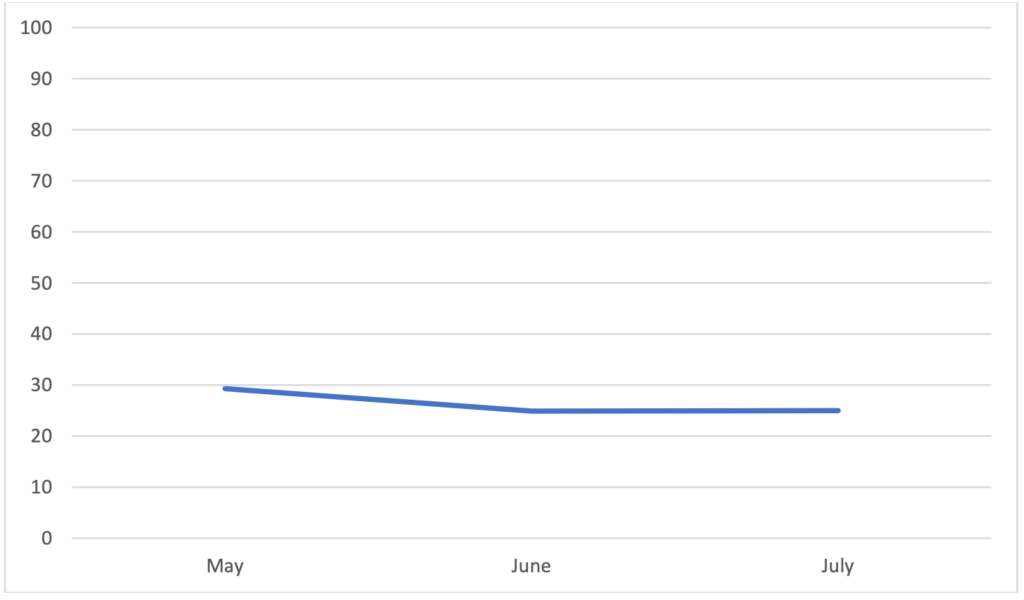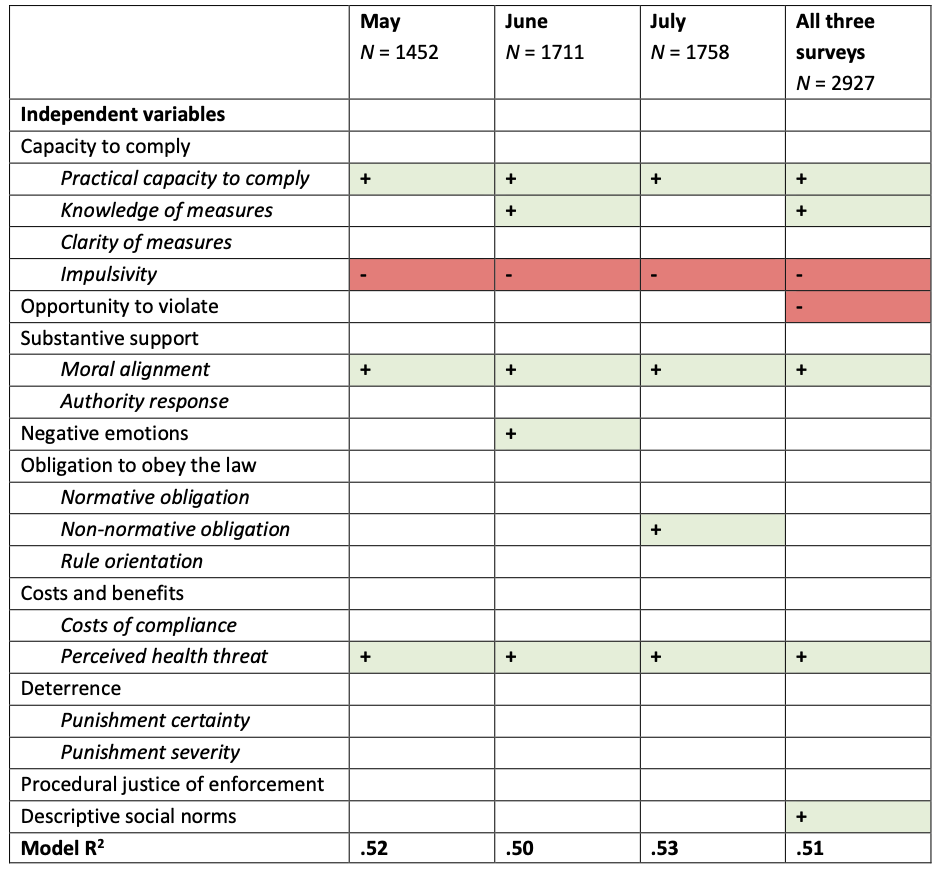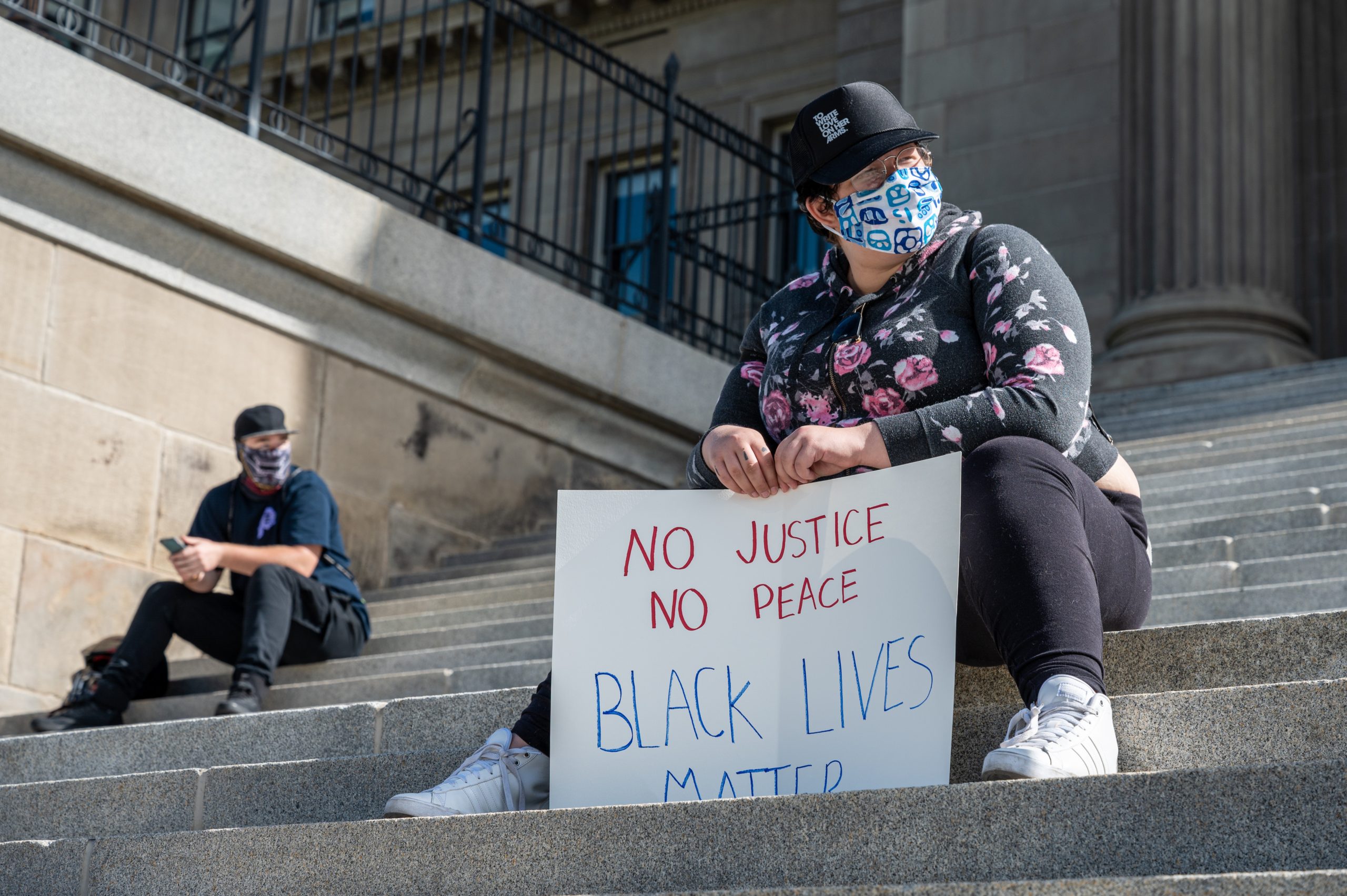Introduction
As there is no effective vaccine available yet, social distancing and stay at home orders are two important measures to mitigate the COVID-19 virus. The real challenge lies in ensuring that people comply with these measures for the necessary weeks and months. This project gathered real- time data in the United States to assess to what extent people complied with COVID-19 mitigation measures in the period between May and July. In addition, the project aimed to understand the reasons for people’s decisions to comply (or not). This report outlines the results.
To study these questions, a multi-wave cohort survey was conducted. A total of three representative samples of American citizens were collected in the period from early May to late July. Each wave measured self-reported compliance with social distancing measures, and various factors that were hypothesized to affect this.
This approach enabled us to (a) track the evolution of compliance with COVID-19 mitigation measures during this period in the United States, and (b) identify with resources sustained or undermined this throughout this period. By doing so, the study provides both descriptive data on compliance of US citizens and insights into the processes that sustain this. In this manner, the study reveals processes that can be targeted in policy to make mitigation measures more effective.
Method
A total of three representative samples of American citizens (roughly N = 1500 per sample) were collected during the period from early May to late July. In each wave, people’s self-reported compliance with social distancing measures in various situations was measured. Data was also collected on key resources that were hypothesized to influence compliance, based on insights from criminology and psychology.
These key resources can be categorized into the following factors:
- People’s capacity to adhere to the rules
- People’s knowledge of the rules
- People’s opportunity to violate the rules
- People’s substantive support for the measures
- People’s emotional state due to COVID-19
- People’s obligation to obey the law
- People’s perceptions of costs and benefits of adherence
- People’s perceptions of deterrence
- Descriptive social norms
This multi-wave approach has enabled us to track the evolution of self-reported compliance with mitigation measures across the period of May to July. More specifically, we captured evolutions in compliance across developments in strictness of the measures (e.g., the reopening of schools, the catering industry, and other public places), in the spread of the virus (e.g., decline and increase), and in public support (e.g., protests and opposition groups). Overall, we could identify which resources are important to sustain greater compliance and which resources undermine it, and how such processes developed across this period of time.
Results
Our results revealed various conclusions: Overall, self-reported compliance with social distancing measures declined significantly from May to June, but stabilized from June to July. Specifically, we observed a decline in both the frequency that participants reported adhering to these measures, and in the percentage of participants who say they always follow the rules (full compliance).

Figure 1. Full compliance (self-reported) in May, June, and July
This study also examined what factors played a role in people’s compliance with social distancing measures across the period from May to July. The table below shows the results for all independent variables for the three surveys separately (monthly regression models), and the three surveys combined (using all data).
Table 1. Factors predicting compliance with mitigation measures in May, June, July, and across three surveys.

As can be seen from the table above, various factors had a significant positive effect on compliance:
- People’s practical capacity to comply (component of capacity to comply) Respondents who reported to have greater capacity to comply with social distancing measures also reported greater compliance. In other words, people for whom it’s feasible to keep a safe distance from others are more likely to comply with the measures.
- People’s knowledge of the measures (component of capacity to comply) Respondents with greater knowledge of social distancing measures showed greater adherence to these rules.
- People’s moral alignment (component of substantive support)
Respondents with strong moral alignment with social distancing measures consistently showed greater compliance. More specifically, respondents who believe that people are morally obliged to comply with the measures are more likely to comply themselves. - People’s perceived health threat (component of people’s perceptions of costs and benefits of adherence) Respondents who regard the virus as more threatening to the health of themselves and others are more likely to adhere to social distancing measures.
- Descriptive social norms
Perceived social norms for keeping a safe distance also predicted greater adherence. This means that people respond to others around them. If more people around them adhere to the rules, they themselves are also more inclined to do so.
There were also two factors that had a significant negative effect on compliance:
- People’s impulsivity (component of capacity to comply)
Respondents with better impulse control reported greater compliance, and respondents with worse impulse control reported less compliance. - People’s opportunity to violate
Respondents with greater perceived opportunities to violate social distancing measures showed lower adherence to the rules.
Results also indicated that various factors seemed unrelated to compliance with social distancing measures. Most important, there were few indications that American citizens’ compliance was affected by obligation to obey the law (their general feeling of duty to obey the law), deterrence (the enforcement of the rules), and personal costs of the virus (e.g., threat of losing income or work).
Conclusions and recommendations for policy
By investigating the effects of various important factors that sustain or undermine compliance with social distancing measures, this project provides important directions for how the US response to COVID-19 can augmented.
First, our findings underline that greater perceptions of threat of the virus are associated with greater compliance. Policy can incorporate such information by maintaining perceptions of threat of the coronavirus, even at times when infections recede. Perceptions of threat have somewhat dropped from May to June, but significantly increased from June to July, which would indicate more and more people realize the coronavirus posits a threat. This might also be due to the resurge in infections (second wave). Nevertheless, these findings show the importance of demonstrating the continuing threat of the virus for persuading people to comply with mitigation measures.
Second, an important factor that plays a role in compliance is people’s substantive support for the measures. People show greater compliance when they morally agree with the measures, and feel morally obliged to follow them. These findings demonstrate that it is important for policy to seek to increase (or retain) support for the measures, for example by highlighting the importance for protecting vulnerable others.
Third, social norms also appeared to be an important factor for compliance. When US citizens perceive that others in their environment are complying, they are more likely to do so themselves. In order to sustain such compliance, policy should sustain social norms towards compliance, and emphasize to people that it is “normal” to comply. However, the current results show that perceived social norms towards compliance have eroded since May, and have continued to do so in July. As more and more people stop to keep a safe distance from others, others who see this will also be less likely to do so. Authorities therefore should focus on demonstrating that social distancing is still the norm. Furthermore, they should take care to not convey the impression that violations are ubiquitous, as doing so may suggest that this is the norm, and further erode compliance.
Fourth, our findings underline that it is crucial to sustain people’s capacity to distance themselves from others, and to reduce opportunities for not doing so. Respondents who were more practically able to follow social distancing measures were also more likely to do so, while opportunities for getting close to others predicted lower compliance. This suggests that authorities can sustain compliance by creating circumstances that allow people to keep distance from others. This may include physical environments that keep people apart, but also personal circumstances that contribute to this – like facilitating telework and online education.
Fifth, it is noteworthy that no deterrence effect was found. In particular, people with greater fear of punishment were not more likely to show greater compliance. This result is not uncommon based on broader findings in criminology, which has shown that in order for punishment to be effective, there has to be threshold level of punishment certainty. This result implies that policy makers should not rely on strong punishment to enforce compliance with social distancing measures.


